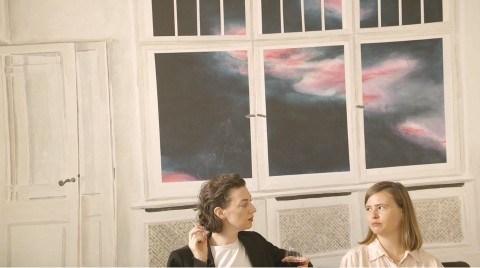Scum Scam Scum (2021) is the second part of German artist Frieder Haller’s cinematic trilogy “Good Times, Bad Timing,” preceded by Architecture (2019) and followed by 24/7 is Not Life (2023). The series features scenarios and dialogue that comment on the fragility and absurdity of relationship dynamics in the post-modern era. The latter does so by focusing on three people stuck inside a black-and-white striped room with no way to escape. In Architecture, an architect plots the murder of an ex-girlfriend using a model of the room where he is planning his attack; however, in a reversal of fortune, she stabs him first. Their respective roommates later discuss the couple and soon grow bored of the topic, turning the conversation to more trivial matters.
Like other works by Haller, Scum Scam Scum is a chamber play with multiple sequences. Set in a renovated apartment, the four main characters include Laura, who hosts a dinner party that quickly devolves into an evening of drama, despair, and oddness. Ben, an unsuccessful architect, arrives at the apartment dressed as a building he never realized. They dine with another couple and a depressed Johnny Depp look-a-like, who wants to live his own life. Ben later professes his love for Laura, who rejects him, leading him to declare her a liar (after forming the letters of the word on a table with miniature sectional sofas). The other couple has a chaotic confrontation. The man claims to kill the woman with his words, and she retaliates by breaking bottles on his head as they deliver vacuous dialogue: “Knowledge is power…. Power is power…. Knowledge is a bitch.” Insecurities and frustrations are revealed through the course of the evening by a host of characters throughout the apartment, all articulated through puns, platitudes, and turns of phrases, some of which are lifted from film and tv sitcoms.
In his films, Haller presents scenarios that involve subjects like murder or unrequited love, which normally would elicit responses of anger, sorrow, or panic. Instead, awkward deadpan exchanges are performed by expressionless actors who deliver their lines with cynical indifference. In their cold, aloof interactions the actors rarely hold eye contact, often staring vacantly into the distance. While odd to observe, by withholding expected dramatic behavior, Haller’s scenes call attention to the structures and power dynamics of the relationships between the characters rather than the actors’ execution of the scenes.
These relationships also are defined by cultural capital, which often is conveyed by the design of one’s space and the objects within it. For example, Haller’s films feature select pieces of modernist furniture—a Corbusier sofa, USM shelving, or Memphis lamps—that indicate privilege and notions of “good taste” while also functioning as forms of separation between people in society. At the same time, sculptures created by Haller appear throughout the apartment in Scum Scam Scum. His quirky pieces, such as a Memphis-style lamp sculpture outfitted with a trailer carrying a miniature Robert Indiana LOVE sculpture and a convex mirror that distorts onlookers’ reflections framed by rows of multi-colored foam-filled rings, mock and challenge the supposed uniqueness and sophistication of modern art and design. Haller suggests that attempts to express individuality through standardized language, design, or architecture are futile and as absurd as many of the goings-on in Laura’s apartment, affirming a sentiment expressed by one of Scum Scam Scum’s dinner guests: “Taste starts at the cheese counter.” – Kanitra Fletcher

